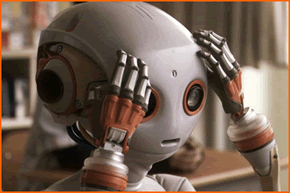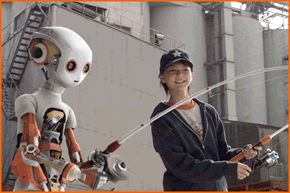|

Japanese
with English & Chinese subtitles
Genre: Fantasy/Drama
Director: Takahiko Akiyama
Starring: Kanata Hongo, Mikako Tabe, Maki
Horikita, Ryoko Kobayashi, Yuta Murakami
RunTime: 1 hr 51 mins
Released By: VideoVan & Golden Village
Rating: PG
Official
Website: http://www.shochikufilms.com
Release
Date: 15 September 2005
Synopsis
:
HINOKIO is not a movie about robots. It is a story of the
heart, of using a remotely controlled robot that can interface
with the real world to restore the relationships that had
become broken, to build bonds between a boy and a girl, a
boy and his father.
Satoru,
a heartbroken boy who had withdrawn into his room, who uses
a remotely controlled robot called HINOKIO as a next-generation
communication tool that provides him with a window on the
world. Using that robot ‘tool’, Satoru is able
to make progress by taking his first cautious, fearful steps
out into the outside world… steps taken from within
his ‘digital cocoon’. Still, he does go to school,
find fellowship and through an encounter with a girl, is able
to reconnect and feel once again the sensation of warm human
touch.
Satoru
eventually seeks to directly experience the world and activates
the robot’s sensation mode, exposing himself to mortal
threat. The girl Jun, risks all by taking action in an attempt
to rescue him. This movie is not just about humans considering
each other with warm affections; it is a movie that, through
the conduct of humans finding love, asks the very question
“What is it to be alive?”
Movie
Review:
If
Spielberg’s “A.I.” was an overdone take
on the Pinocchio fable, then “Hinokio” must be
its quieter, subtler cousin. After an emotionally crippling
accident, twelve year-old Satoru (Kanata Hongo) ceases contact
with the world – until a super-robot, nicknamed Hinokio,
is built for him. Hinokio substitutes Satoru’s attendance
in school while the latter operates it from the confines of
his room, which is nearly foolproof if not for all those cumbersome
music and P.E. lessons. As bullies come and go, Hinokio/Satoru
eventually manages to find a friend in Jun (Mikako Tabe),
who has a surprise for us - and Satoru. They go fishing together
and run around in a rainstorm. Guess what happens when the
scary thunder sounds?
What
is stunning in “Hinokio” is the gradual and completely
convincing ambiguity of Hinokio, both as a robot and as Satoru
himself. There are times when it’s obvious Hinokio is
merely a machine, but tender moments, which are aplenty, are
hardly foiled by the fact that it is nothing but a combination
of plastic and alloys. When Jun and Hinokio share a spontaneous
embrace, it is a powerful moment. The hug is immediately affecting
in conveying Jun and Satoru’s impossible friendship,
but simultaneously poignant and sad – Satoru is still
alone in his room. The impeccable care accorded to developing
the character arc of Hinokio/Satoru is nothing short of exemplary,
somewhat of a drag, perhaps, but the returns are no doubt
worth it.
There
is a subplot concerning a computer game called Purgatory,
which I found to be slightly excessive and overly fantastical.
If Hinokio was meant to bridge the gap between the Satoru
and the world he has refused, and eventually convince Satoru
that a secondary experience with the outside world is unsatisfying,
what then, is the purpose of introducing a subplot that examines
the reality of a cyber world at the expense of the real world?
It seemed to undermine and undo all the efforts in developing
the Hinokio/Satoru arc and eventually rob the movie of its
simple yet satisfying emotional vein.
Other
subplots included the confusing character of Takasaka (Ryoko
Kobayashi), who is the mind-boggling anti-heroine, and the
introduction of Eri (Maki Horikita) as a possible love interest
for Satoru. Through these characters, some social commentary
regarding the school culture and teenage demographic in Japan
is hinted at, but I might be reading too much into this. Regardless,
the scenes were rather awkward and often broke the pace of
this otherwise poignant film. One gets the feeling that these
subplots were inserted for the sake of beefing up the relatively
bare central story and in hope of targeting a younger, more
lucrative audience. The result is a consequentially less emotionally
mature film, which is a pity, since “Hinokio”
definitely has all the makings of a truly devastating hit.
What
was worth looking at was the strained relationship between
Satoru and his father, Kaoru Iwamoto (Masatoshi Nakamura).
Father and son are at tension and despite dad’s relentless
attempts to reach out, Satoru refuses to forgive the man he
holds accountable for the aforementioned accident. Notes are
passed and phone messages ignored, real communication between
the two only, finally happens through Hinokio. Hinokio is
essentially what helps Satoru do what he cannot, say what
he will not and realize what he did not – that life
is not complete, despite all of technology’s wonders,
without real relationships.
In
a striking scene (my favourite), Satoru exchanges words with
his father for the first time since the accident by speaking
through the robot. The words are hurtful but Iwamoto is spared
the raging presence of his son and instead, breaks down silently
in front of the monotonous Hinokio. It is simple, affecting,
perfect and indeed what the movie should have been all about.
Movie
Rating:
  
(For “Hinokio”, less would have been so much more.
If only it stuck with Satoru and nothing else!)
Review
by Angeline Chui
Talk
about "Hinokio" in our forum!
|






